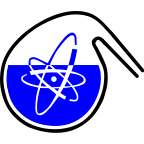Abstract
Anthropogenic I release increased the I/I ratio by several orders of magnitude. In the 1960s, detonations of atmospheric nuclear weapons contributed to the I release; today the main sources are the reprocessing plants in La Hague and Sellafield. 90 % of I is released into the ocean, gaseous emissions account for only 10 %. Today, this continuous release has increased the I/I isotopic ratios from some 10 in the prenuclear age to 10 or higher in wide parts of Europe.
Numerous measurements of water samples from the English Channel to the North Sea were published. Total activity concentrations of I and isotopic ratios in sea water are well known. However, findings by Hou et. al.[1, 2] indicate disequilibria of the chemical species containing I compared to those containing I. The present work aims at understanding chemical speciation of the released I. Chemical reactions and kinetic aspects of iodine chemistry in sea water are modelled.
Water samples were taken in the vicinity of La Hague. In addition to total I and I, chemical speciation was investigated at trace concentrations, differentiating iodide, iodate and organo-iodine species.
The results show higher contents of I in sea water around La Hague compared to measurements from the North Sea. In addition, the I content was higher at the southwest coast of La Hague as compared to the northeast coast. I/I ratios of 10 up to 10 were found for total iodine and iodate, while I/I ratios of 10 to 10 were measured for the iodide fraction. Iodate/iodide ratios show lager variation for I with values between 2.6 to 7.4 compared to I with a range from 1.6 to 4.5. In addition, iodate/iodide ratio of I decreased with the distance to La Hague, while the iodate/iodide ratio of I did not show any correlation with the distance. Further indication for organic bound iodine co-eluting with iodide was found.
In addition, laboratory batch experiments were performed to simulate the behavior of radioactive I. Different iodine chemistry in sea water compared to deionized water was studied with I as iodide in a first experiment. A second experiment was performed with iodate and iodide in synthetic sea water to compare the behavior of the two species. In a third step, organic molecules were added as possible reaction partners for the iodine species.
An equilibrium between iodate and iodide was obtained. Iodate spiked solutions contained 10 to 20 % of iodide. Similarly, iodide spiked solutions contained 10 to 20 % iodate as measured by I gamma ray spectrometry.
References
[1] X. Hou, Chemical Speziation of Long-Live Radionuclides in the Environment. Technical University of Denmark, Roskilde, 2008.
[2] X. Hou, A. Aldahan, S. P. Nielsen, G. Possnert, H. Nies, J. Hedfors, Speciation of I and I in Seawater and Implications for Sources and Transport Pathways in the North Sea, Journal of Environmental Science and Technology 2007, 41, 5993-5999.

